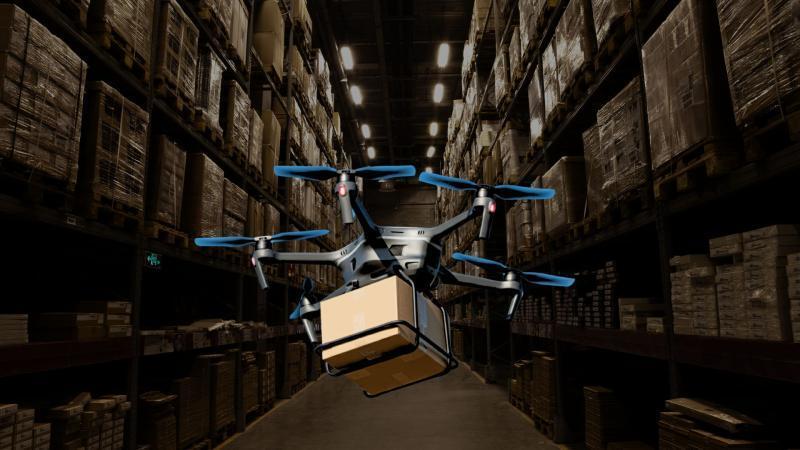
New Tech Optimises Drone Fleets for Faster, Greener Deliveries
The future of logistics is here, and it’s flying high. Drones have long been touted as a solution to the last-mile delivery problem, promising faster and more efficient delivery of packages to our doorsteps. However, one major hurdle has held back the widespread adoption of drone delivery: the Drone Warehouse Problem. This refers to the challenge of optimising drone delivery schedules to ensure that warehouses can efficiently manage varied drone fleets, ensuring parcels reach customers quickly and reliably.
Researchers have made significant strides in addressing this challenge, developing a novel algorithm that tackles the Drone Warehouse Problem head-on. This breakthrough technology has the potential to revolutionise the logistics industry, enabling faster and greener deliveries that benefit both businesses and the environment.
The Drone Warehouse Problem: A Complex Challenge
The Drone Warehouse Problem is a complex logistics challenge that arises from the unique characteristics of drone delivery. Unlike traditional delivery methods, drones require specific scheduling and routing to ensure efficient and reliable delivery. This is because drones operate in a three-dimensional environment, with varying weather conditions, airspace restrictions, and delivery routes that require careful planning.
To overcome these challenges, logistics companies must develop sophisticated algorithms that can optimise drone delivery schedules in real-time. This involves considering a multitude of factors, including:
- Drone availability and capacity
- Package volume and weight
- Weather conditions and airspace restrictions
- Delivery routes and traffic patterns
- Time-sensitive delivery requirements
The Novel Algorithm: A Game-Changer for Drone Delivery
Researchers have developed a novel algorithm that addresses the Drone Warehouse Problem by optimising drone delivery schedules. This algorithm uses machine learning and data analytics to predict and adapt to changing conditions in real-time, ensuring that drones are deployed efficiently and effectively.
The algorithm works by:
- Analyzing historical data on drone performance, weather patterns, and delivery routes
- Predicting future conditions and adjusting drone deployment accordingly
- Optimising drone routes and schedules to ensure efficient delivery
- Identifying and mitigating potential disruptions, such as weather events or airspace restrictions
Benefits of Optimised Drone Fleets
The benefits of optimised drone fleets are numerous and far-reaching. By addressing the Drone Warehouse Problem, logistics companies can:
- Reduce delivery times: By optimising drone delivery schedules, companies can reduce delivery times and increase customer satisfaction.
- Increase efficiency: The algorithm’s ability to predict and adapt to changing conditions ensures that drones are deployed efficiently and effectively, reducing downtime and increasing overall productivity.
- Minimise environmental impact: By reducing delivery times and increasing efficiency, companies can reduce their carbon footprint and contribute to a more sustainable future.
- Scale up operations: With the ability to manage varied drone fleets and optimise delivery schedules, logistics companies can scale up their operations to meet growing demand.
- Improve customer experience: By providing faster and more reliable delivery, companies can improve customer satisfaction and build loyalty.
The Future of Last-Mile Delivery
The development of this novel algorithm marks a significant milestone in the evolution of last-mile delivery. As the logistics industry continues to evolve, we can expect to see more widespread adoption of drone technology, driven by the need for faster, more efficient, and more sustainable delivery solutions.
With the Drone Warehouse Problem addressed, logistics companies can now focus on scaling up their operations and meeting growing demand. This has significant implications for the environment, as reduced delivery times and increased efficiency can lead to a significant reduction in carbon emissions.
Conclusion
The optimisation of drone fleets for faster, greener deliveries is a game-changer for the logistics industry. By addressing the Drone Warehouse Problem, researchers have developed a novel algorithm that enables logistics companies to manage varied drone fleets and optimise delivery schedules in real-time.
As the industry continues to evolve, we can expect to see more widespread adoption of drone technology, driven by the need for faster, more efficient, and more sustainable delivery solutions. With the development of this algorithm, we are one step closer to a future where packages arrive quickly, reliably, and with a smaller environmental footprint.
Source:
https://researchmatters.in/news/novel-algorithm-tackles-drone-warehouse-problem-faster-deliveries






